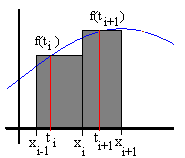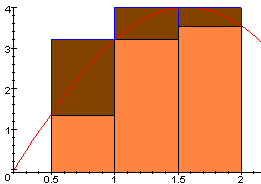Prove That F is Riemman Sum Integrable if F is Continuous at 0 Rudin Solution Beta3
7. The Integral
7.1. Riemann Integral
In a calculus class integration is introduced as 'finding the area under a curve'. While this interpretation is certainly useful, we instead want to think of 'integration' as more sophisticated form of summation. Geometric considerations, in our situation, will not be so fruitful, whereas the summation interpretation of integration will make many of its properties easy to remember.
First, as usual, we need to define integration before we can discuss its properties. We will start with defining the Riemann integral and we will move to the more technical but also more flexible Lebesgue integral later.
| Definition 7.1.1: Partition of an Interval | |
A partition P of the closed interval [a, b] is a finite set of points P = { x0, x1, x2, ..., xn} such that a = x0 < x1 < x2 < ... < xn-1 < xn = bThe maximum difference between any two consecutive points of the partition is called the norm or mesh of the partition and denoted as | P |, i.e. | P | = max { xj - xj-1, j = 1 ... n }A refinement of the partition P is another partition P' that contains all the points from P and some additional points, again sorted by order of magnitude. | |
Using these partitions, we can define the following finite sum:
| Definition 7.1.3: Riemann Sums | |
If P = { x0, x1, x2, ..., xn} is a partition of the closed interval [a, b] and f is a function defined on that interval, then the n-th Riemann Sum of f with respect to the partition P is defined as: R(f, P) =where tj is an arbitrary number in the interval [xj-1, xj]. | |
 | Note: If the function f is positive, a Riemann Sum geometrically corresponds to a summation of areas of rectangles with length xj - xj-1 and height f(tj). |
| Examples 7.1.4: | |
| |
Riemann sums have the practical disadvantage that we do not know which point to take inside each subinterval. To remedy that one could agree to always take the left endpoint (resulting in what is called the left Riemann sum) or always the right one (resulting in the right Riemann sum). However, it will turn out to be more useful to single out two other close cousins of Riemann sums:
| Here is an example where the upper sum in displayed in dark brown and the lower sum in light brown. The partition P = {0.5, 1, 1.5, 2}, and the numbers for the sums are chosen:
|  |
These various sums are related via a basic inequality, and they are also related to a refinement of the partition in the following theorem:
In other words, the lower sum is always less than or equal to the upper sum, and the upper sum is decreasing with respect to a refinement of the partition while the lower sum is increasing with respect to a refinement of the partition. Hence, a natural question is: will the two quantities ever coincide ?
| Definition 7.1.8: The Riemann Integral | |
Suppose f is a bounded function defined on a closed, bounded interval [a, b]. Define the upper and lower Riemann integrals, respectively, as I*(f) = inf{ U(f,P): P a partition of [a, b]}Then if I*(f) = I*(f) the function f is called Riemann integrable and the Riemann integral of f over the interval [a, b] is denoted by
| |
Note that upper and lower sums depend on the particular partition chosen, while the upper and lower integrals are independent of partitions. However, this definition is very difficult for practical applications, since we need to find the sup and inf over any partition.
The third example shows that not every function is Riemann integrable, and the second one shows that we need an easier condition to determine integrability of a given function. The next lemma provides such a condition for integrability.
Now we can state some easy conditions that the Riemann integral satisfies. All of them are easy to memorize if one thinks of the Riemann integral as a somewhat glorified summation.
Now we can illustrate the relation between Riemann integrable and continuous functions.
Note that this theorem does not say anything about the actual value of the Riemann integral. Also, we have as a free extra condition that that f is bounded, since every continuous function on a compact set is automatically bounded.
Since differentiable functions are continuous, this result implies that
{ differentiable functions }{ continuous functions }
{ integrable functions }
and each set is in fact a proper subset of the next.
| Examples 7.1.15: | |
| |
To finalize the relation between integrable and continuous functions, the following theorem can be proved (but it uses the concept of a measure, defined later):
| Theorem 7.1.16: Lebesgue's Theorem | |
| If f is a bounded function defined on a closed, bounded interval [a, b] then f is Riemann integrable if and only if the set of points where f is discontinuous has measure zero. | |
A set of measure zero, as we will see later, is any set of finitely or countably many points. Therefore, we could rephrase the above exact theorem as follows:
The converse is not quite true: If f is a bounded function defined on a closed, bounded interval [a, b] and f is Riemann integrable, then f is continuous on [a, b] except possibly at a set of measure zero, but a set of measure zero does not necessarily consist of countably many points.
Now that we have easy conditions to determine which functions are integrable, it would also be convenient to have a nice shortcut to easily compute the actual value of an integral.
| Theorem 7.1.19: Fundamental Theorem of Calculus | |
Suppose f is a bounded, integrable function defined on the closed, bounded interval [a, b], define a new function: F(x) =Then F is continuous in [a, b]. Moreover, if f is also continuous, then F is differentiable in (a, b) and F'(x) = f(x) for all x in (a, b)In many calculus texts this theorem is called the Second Fundamental Theorem of Calculus. | |
This theorem has an easy corollary that enables us to quickly find the value of an integral in many situations.
| Corollary 7.1.20: Integral Evaluation Shortcut | |
Suppose f is an continuous function defined on the closed, bounded interval [a, b], and G is a function on [a, b] such that G'(x) = f(x) for all x in (a, b). Then The function G is often called Antiderivative of f, and this corollary is called First Fundamental Theorem of Calculus | |
Before we look at several examples, we should rephrase these results in less rigorous notation. The first theorem says, basically:

f(x) dx = f(x)
while the corollary states, basically, that:

f(x) dx = f(b) - f(a)
Hence, loosely speaking, integration and differentiation are inverse operations of each other.
In the next chapter we will learn some more shortcuts to compute the value of an integral called substitution method and integration by parts.
Source: https://mathcs.org/analysis/reals/integ/riemann.html
 f(tj) (xj - xj-1)
f(tj) (xj - xj-1)  f(x) dx
f(x) dx  f(t) dt
f(t) dt
0 Response to "Prove That F is Riemman Sum Integrable if F is Continuous at 0 Rudin Solution Beta3"
Post a Comment